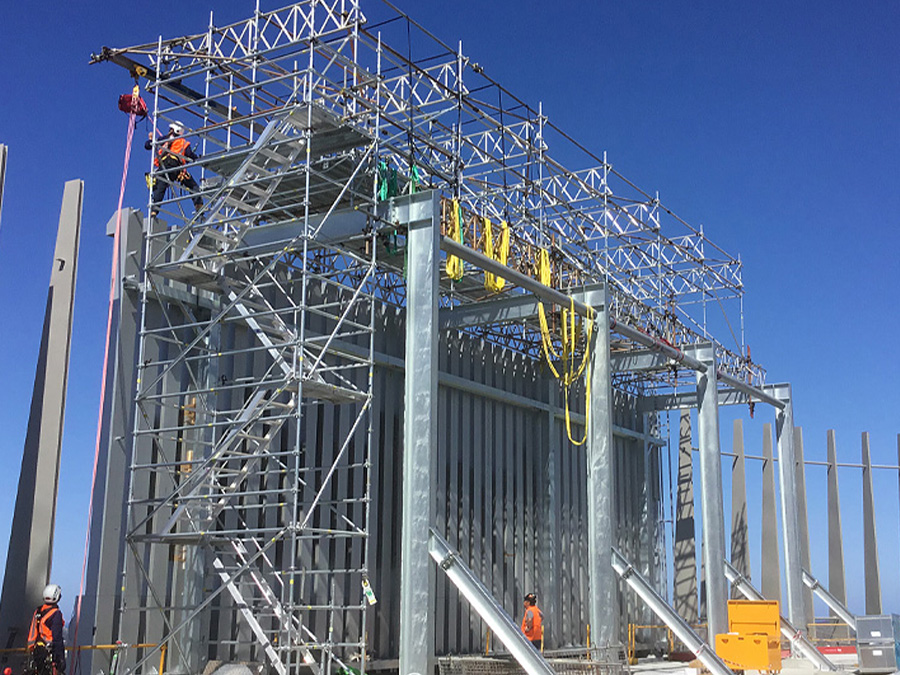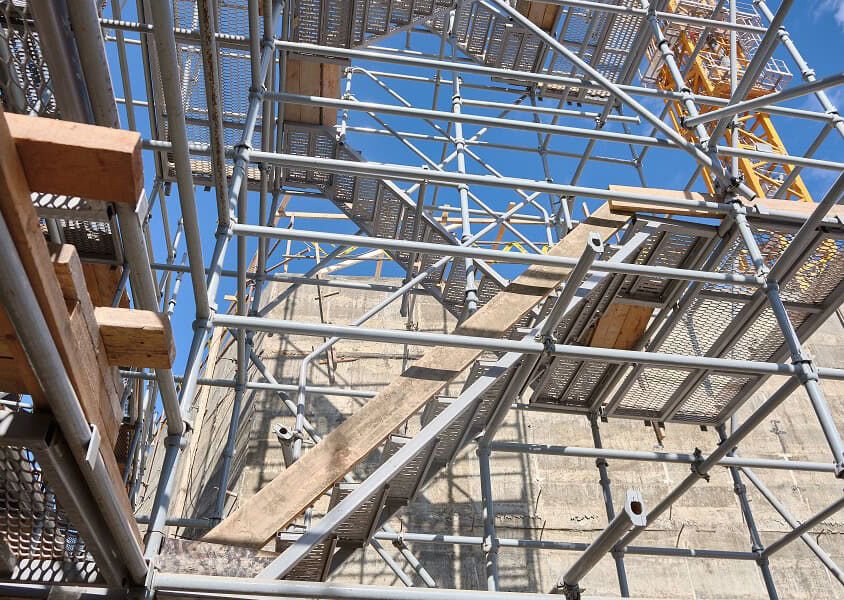Expert Scaffolder Surrey Offering Customized Solutions for Your Needs
Expert Scaffolder Surrey Offering Customized Solutions for Your Needs
Blog Article
A Comprehensive Guide to the Important Features of Scaffolding in Modern Building And Construction
The landscape of modern-day building progressively counts on efficient scaffolding systems that prioritize safety, performance, and advancement. As tasks expand in complexity, recognizing the vital features of scaffolding ends up being crucial for ensuring worker safety and security and optimizing job timelines. This overview explores different sorts of scaffolding, highlights key safety attributes, and analyzes material advancements that contribute to efficiency and sustainability. However, the ramifications of these components extend much beyond simple building and construction techniques, prompting a better look at exactly how they affect total task success and worker well-being.
Sorts Of Scaffolding
Although scaffolding systems can differ commonly in design and application, they generally come under a number of distinct groups that cater to different construction demands - Scaffolding. The most common kinds consist of sustained scaffolding, suspended scaffolding, and rolling scaffolding
Sustained scaffolding consists of systems sustained by a framework of posts, which supply a raised and stable functioning surface. This kind is normally utilized for tasks that need significant altitude, such as bricklaying or exterior paint.
Put on hold scaffolding, conversely, is made use of for jobs calling for accessibility to high elevations, such as cleaning or repairing building exteriors. This system hangs from another structure or a roof, permitting employees to reduced or increase the system as required.
Moving scaffolding features wheels that enable simple flexibility throughout a task website. It is specifically beneficial for jobs that require constant moving, such as indoor operate in large spaces.
Each sort of scaffolding is developed with certain applications in mind, ensuring that construction projects can be performed successfully and effectively. Understanding these classifications is vital for choosing the ideal scaffolding system to meet both project requirements and site conditions.
Secret Security Functions
Security is vital in scaffolding systems, as the prospective threats related to operating at elevations can cause significant accidents otherwise effectively taken care of. Trick security functions are necessary to make certain the health of employees and the stability of the building website.
Primarily, guardrails are critical. These obstacles give a physical guard versus falls, considerably minimizing the risk of major injuries. Additionally, toe boards are usually made use of to stop tools and products from diminishing the scaffold, securing workers listed below.
One more crucial element is the use of non-slip surface areas on platforms. This attribute boosts hold, especially in negative weather, consequently minimizing the possibility of drops and slides. Additionally, access ladders must be firmly positioned to help with secure entry and departure from the scaffold.
Regular assessments and upkeep of scaffolding systems are likewise important. These inspections make sure that all components remain in great problem and working appropriately, addressing any type of wear or damage immediately.
Lastly, appropriate training for all employees involved in scaffolding operations is important to guarantee that they comprehend safety and security protocols and can determine potential dangers. Scaffolding. Jointly, these attributes create a safer working atmosphere and dramatically mitigate dangers related to scaffolding
Product Technologies
Developments in material science have actually considerably affected the scaffolding sector, boosting both safety and security and efficiency in contemporary building and construction. The intro of high-strength steel and aluminum alloys has actually revolutionized standard scaffolding systems. These materials are not just lighter, making them less complicated to move and assemble, yet additionally give superior load-bearing abilities. This results in scaffolding frameworks that can sustain higher weights while minimizing the risk of collapse.
Furthermore, ingenious composite materials, such as fiberglass-reinforced plastics, have actually arised as feasible alternatives. These materials are immune to rust and environmental destruction, hence expanding the life expectancy of scaffolding systems, particularly in harsh weather. Using such materials adds to lower upkeep expenses and ensures consistent efficiency in time.


Style Considerations
Thinking about the complexities of modern-day building and construction projects, effective scaffolding design is extremely important to ensuring both functionality and safety. Style considerations must include numerous variables, including load capability, height, and the particular needs of the building and construction site. Each project offers special obstacles, demanding a flexible approach to scaffolding systems that can adapt to differing conditions.
Architectural stability is vital; therefore, engineers have to determine the lots that the scaffolding will certainly support, including employees, products, and tools. The option of materials plays a vital function in making certain the scaffolding can hold up against these loads while continuing to be light-weight and durable. Additionally, the style has to enable for very easy accessibility and egress, helping with the smooth activity of materials and personnel.
Safety functions, such as guardrails and non-slip surfaces, should be included to minimize risks of crashes. Additionally, the layout needs to think about the surrounding environment, including nearby frameworks and prospective hazards. By dealing with these design factors to consider, building and construction companies can improve the performance of scaffolding systems and advertise check my reference a much safer working environment, ultimately adding to the total success of the project.
Upkeep and Inspections
The effectiveness of scaffolding systems prolongs beyond first style and execution; continuous upkeep and routine inspections are vital to guaranteeing their proceeded efficiency and safety throughout the duration of a task. Routine assessments need to be performed by qualified personnel to identify any type of signs of wear, damages, or instability that might jeopardize the integrity of the scaffolding.
Upkeep procedures must consist of regular checks of architectural elements, such as frames, slabs, and fittings, making sure that all elements remain free and protected from corrosion or other deterioration. In addition, the functionality of safety and security features, such as guardrails and toe boards, need to be examined to make sure conformity with security policies.
Documentation of all inspections and maintenance tasks is essential for responsibility and regulatory compliance. An organized strategy to record-keeping not just aids in tracking the condition of the scaffolding however also offers essential scaffolding vygotsky example proof in the event of an occurrence.
Eventually, developing a detailed upkeep and evaluation timetable will considerably minimize the risk of accidents and boost the general security of the building and construction website. By focusing on these methods, building managers can safeguard employees and copyright the job's honesty.

Conclusion
In conclusion, the vital functions of scaffolding in contemporary construction include a series of vital aspects, including varied kinds, vital security devices, material innovations, and thoughtful layout factors to consider. Emphasizing security through guardrails and non-slip surface areas, together with improvements in materials like high-strength steel, boosts both efficiency and sustainability. Additionally, regular upkeep and examinations are essential for guaranteeing structural stability and safety on building and construction websites, eventually promoting effective project implementation and promoting the health of workers.
The landscape of modern building significantly depends on effective scaffolding systems that prioritize performance, safety, and development.Innovations in material science have dramatically affected the scaffolding industry, enhancing both safety and security and performance in modern construction. In general, these material advancements not just enhance the performance and safety of scaffolding systems but likewise line up with the sector's press in the direction of sustainability, as many modern useful site materials are designed to be a lot more eco pleasant.
Considering the intricacies of contemporary building jobs, reliable scaffolding design is extremely important to ensuring both performance and security.In final thought, the necessary functions of scaffolding in contemporary construction encompass a range of crucial elements, including varied kinds, vital security systems, material innovations, and thoughtful layout considerations.
Report this page